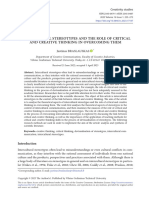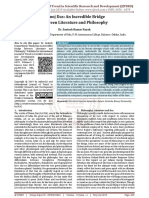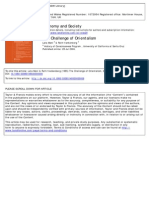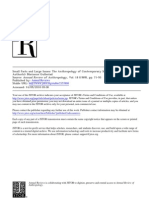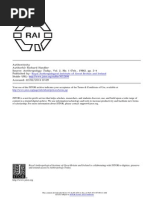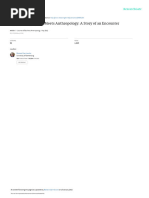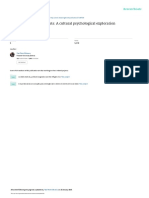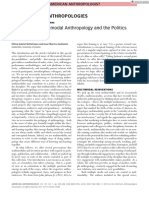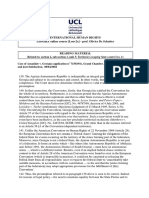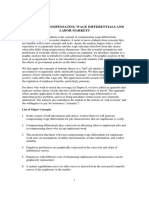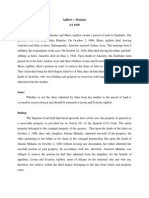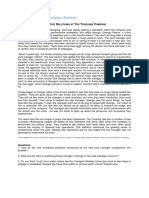Mercenariesmissionaries
Mercenariesmissionaries
Uploaded by
Joy NapierCopyright:
Available Formats
Mercenariesmissionaries
Mercenariesmissionaries
Uploaded by
Joy NapierOriginal Title
Copyright
Available Formats
Share this document
Did you find this document useful?
Is this content inappropriate?
Copyright:
Available Formats
Mercenariesmissionaries
Mercenariesmissionaries
Uploaded by
Joy NapierCopyright:
Available Formats
Article
Critique of Anthropology
33(3) 263–279
Beyond the looking ! The Author(s) 2013
Reprints and permissions:
glass? ‘Aidland’ sagepub.co.uk/journalsPermissions.nav
DOI: 10.1177/0308275X13490308
reconsidered coa.sagepub.com
Elizabeth Harrison
University of Sussex, UK
Abstract
This paper engages with an emerging genre in anthropology’s engagement with inter-
national development – writing about ‘Aidland’ which focus attention on the lives,
motivations and personalities of ‘development professionals’. It suggests that there
are two possible problems with the growing popularity of work on Aidland: first, that
it rests on a reified and dated view of the worlds of aid and development; second, that
an ethnographic focus on development professionals may serve to divert attention to
the significance of both the politics and the material effects of development intervention
and the relations of power within which they are embedded.
Keywords
Aidland, aid, development, ethics, anthropology
Introduction: Anthropologies of ‘Aidland’
The long history of anthropology’s engagement with international development
has recently witnessed the emergence of a new genre of writing. This focuses atten-
tion on the lives of ‘development professionals’ themselves, treated as an object of
enquiry in their own right, rather than primarily the vehicles for the creation and
implementation of policy. A common thread running through much of this work is
the concept of ‘Aidland’, first developed by Raymond Apthorpe, but now more
widely articulated. For Apthorpe,
‘Aidland [. . .] is the trail (to use a word that usefully is both verb and noun, and about
both process and place) of where foreign aid comes from, where it goes, and what then.
Stepping into Aidland is like stepping off one planet into another, a virtual another, not
that this means that it is any the less real to those who work in or depend on or are
affected by it in other ways’ (Apthorpe, 2005: 1).
Corresponding author:
Elizabeth Harrison, University of Sussex, Falmer, Brighton BN1 9SJ, UK.
Email: e.a.harrison@sussex.ac.uk
Downloaded from coa.sagepub.com at PENNSYLVANIA STATE UNIV on May 16, 2016
264 Critique of Anthropology 33(3)
This Aidland is a compelling allegory. Like Lewis Carroll’s Alice in Wonderland
and Through the Looking Glass, it is similarly something of a fantasy land, detached
from the realities of the other ‘lands’ it is meant to be aiding. Indeed its attract-
iveness for those who read and write about it might partly lie in the fact that it rings
true. There can be something fantastical about the workings of much aid work; it
can appear to be sealed and separate – a ‘bubble’, with its own rituals, symbolism
and language. It is also parochial, nostalgic, imbued with ‘good intentions’, but
often riven by self-doubt, and fear, unspoken racism and hypocrisy.
In this paper, I explore the reasons for the emergence of this genre and raise
some questions about its broader implications for anthropology’s engagement with
international development, which includes, but is not limited to, its manifestations
in aid. I appreciate that in writing of a ‘genre’ I am in danger of glossing over the
significant differences between the approaches and arguments of different scholars.
Importantly, a distinction should be made between that work which is rooted in
analysis of institutional processes and that which focuses more on the personal. It is
the latter which gives rise to my particular concerns. Nonetheless, I would argue
that there are sufficient commonalities – and indeed that ‘Aidland’ itself has
become a sufficiently recognised trope – for my argument to have substance.
There are two principal aspects to this argument. First, that there is danger that
‘Aidland’ presents a rather dated picture that fails to account for the emergence of
new actors and discourses in the architecture of aid and in the relationship between
aid and development. Second, that an ethnographic focus on development profes-
sionals may serve to divert attention from the significance of both the politics and
the material effects of development intervention while reinforcing a dichotomous
picture of the relationship between ‘developers’ and ‘recipients’. It may also inad-
vertently contribute to a growing pathologisation of aid processes and practices.
The paper thus aims to be a reminder of the value of insights that provide
understanding of all dimensions and actors in the development process and the
relationships between them. I am not suggesting that analysis of ‘Aidland’ is the
only way that anthropologists are currently engaging with aid and development –
far from it.1 It is also the case that most of those who write about ‘Aidland’ have
also written extensively about development outcomes and structures in other pub-
lications. The object of my criticism is not this body of work, so much as the
construction of ‘Aidland’ as an object of enquiry in its own right, and particularly
its emphasis on the personal. Has it become too inward looking, even narcissistic?
Aidland: The emergence of a genre
So what is the ‘Aidland’ genre and why did it arise? I have noted that Raymond
Apthorpe probably first coined the term, but many writers are now contributing to
it. One influential manifestation is Stirrat’s (2008) paper ‘Mercenaries, missionaries
and misfits: representation of development personnel’, published in Critique
of Anthropology. In this paper, Stirrat argues that we still know relatively little
about the people involved in the aid industry and an anthropological
Downloaded from coa.sagepub.com at PENNSYLVANIA STATE UNIV on May 16, 2016
Harrison 265
understanding should focus on the ‘culture’ of such individuals: what people think
of each other and themselves ‘and how they understand their role in the development
process’(2008: 408). In an earlier paper, Stirrat (2000) made a similar argument,
with particular attention to the culture of the world of international consultancy,
which, he suggests, is as much about aesthetics as it is about the pragmatic effects
of consultants’ work. More recently, the genre has been manifested in a forum in
the online magazine ‘the Broker’, in which contributors discuss and reflect upon
their experiences as development professionals, and in web-based discussions of
‘aidnography’ (e.g. the blog, aidnography.blogspot.com).2 Researchers working
within, and associated with, the Institute of Development Studies (IDS) at
Sussex University, although not all anthropologists by disciplinary background,
have also stressed the importance of ‘relationships for aid’ (Eyben, 2006).
The genre has come together in particularly clear form in the last two years
with the publication of two volumes, Adventures in Aidland: the Anthropology
of Professionals in International Development, edited by David Mosse (2011a)
and Inside the Everyday Lives of Development Workers: the Challenges and
Futures of Aidland (Fechter and Hindman, 2011). Both volumes have an ethno-
graphic, anthropologically-informed, approach to their subject matter. In this,
the ways in which development professionals negotiate issues of identity,
gender and race, as well as the tensions and difficulties of their jobs, take
centre stage. Contributors to the two volumes have, in different ways, been
engaged in the project of development – as practitioners, advisers, consultants,
insiders. Some are ‘old hands’, reflecting on years of involvement; this is par-
ticularly the case with Adventures in Aidland. Others are newer to the business;
the majority of contributors to Inside the Everyday Lives of Development
Workers are relatively earlier career anthropologists, often having spent time
as PhD students associated with aid organisations and in this context explicitly
conducting research on development actors.
The books differ in focus: Adventures in Aidland is more engaged with institu-
tional relations and knowledge practices, primarily within multilateral and bilateral
aid agencies such as the World Bank and DFID – the ‘mercenaries’ of Stirrat’s
characterisation. It thus builds explicitly on well-established anthropological inter-
rogations of the development industry. Inside the Everyday Lives of Development
Workers is more directly concerned with the social worlds of aid workers them-
selves and with the nature of the work they do, more with personal relationships
and less with wider institutional analysis. Its contributors draw primarily on
research and experience with national and international NGOs – perhaps more
like Stirrat’s ‘missionaries’. Each book contains a concluding reflection by
Raymond Apthorpe, which, perhaps anticipating criticism, serves to somewhat
destabilise the apparent coherence of ‘Aidland’. As he puts it, the metaphor of a
‘land’ tends to ‘accentuate the essentialist, holistic singular, and perennial . . . ’, as
opposed, for example, to ‘space’ metaphors which accentuate the interpretevist,
plural, and the dynamics of a pattern of organisation and power’ (Apthorpe,
2011a: 199).
Downloaded from coa.sagepub.com at PENNSYLVANIA STATE UNIV on May 16, 2016
266 Critique of Anthropology 33(3)
The idea of Aidland has both pragmatic and reflexive roots. As noted, many of
the authors contributing to the new genre, particularly those contributing to
Adventures in Aidland, have spent considerable time directly engaged in aid
work. Some have been consultants to or formal employees of aid organisations.
Many did not set out explicitly to ‘study developers’ and have also already written
extensively in ways that directly contribute to aid through consultancy reports or in
their day-to-day employment. With time to reflect, the world of aid thus provides a
rich vein of material, gathered through daily encounters and gradual familiarity.
These commentators on ‘Aidland’ then refer back to the usual source material
of the anthropologist, collected over time: journal entries, notes, ‘odd snippets of
emails to family and friends’ (Eyben, 2006: 92), memory, detailed accounts of
events that all contribute to provide ‘thick description’.
The existence of such material may be more serendipitous than the result of
a specific set of research questions. Stirrat (2000), for instance, draws on some
10 years of experience as a short term development consultant for much of the
source material in his ‘Cultures of consultancy’ article, though this is also supple-
mented by material from a specific research project on the development industry in
Sri Lanka. As David Mosse puts it in the foreword to Adventures in Aidland: ‘Their
insights do not arise from conventional anthropological research projects, but are the
result of reflection on experience of living and working as part of the interconnected
expert world of international development (Mosse, 2011a: vii). He points out that for
many anthropologists in the 1980s, himself included, the squeeze in job opportu-
nities for anthropologists in the UK academia resulted in them taking up employ-
ment in non-academic institutions, including in international development. Later,
positioning within an academic department provides an opportunity to reflect upon
these experiences.
Such reflections are not necessarily, ‘confessional tales’ (Van Maanen, 2011),
only occasionally referring to the position of the ethnographer him/herself.
However, reflexivity can also play a role in the emergence of ‘Aidland’. A 2010
special issue of Anthropology Matters, the UK journal for postgraduate and early
career anthropologists (Pollard and Street, 2010), considers the opportunities and
problems for anthropologists as – and engaging with- development professionals.
As they note, for those who have been engaged with international development
over many years, ‘watching developers’ is an opportunity to reflect on their own
role in this – to interrogate their own motivation and actions. It is also important as
part of a sensitivity to the politics of representing others which has become so
important to contemporary anthropology. This can become particularly acute
when working in contexts of trauma and grief, in which attention to the ‘the
affective, as well as representational’ aspects of ethnography is important
(Pollard and Street, 2010: 2). Shutt (2006) is explicit about her motivation: the
concept of Aidland provides an opportunity for reflection on her own role as an
aid-worker, and on the power relations that this entailed. As she puts it, this pro-
cess can be ‘deeply discomforting’ (Shutt, 2006: 79) as it forces one to acknowledge
the possibility of one’s own role in reproducing unequal power relations, or having
Downloaded from coa.sagepub.com at PENNSYLVANIA STATE UNIV on May 16, 2016
Harrison 267
‘selfish’ motivations alongside ‘noble intentions’ (Shutt, 2006: 80). The honesty of
her account of a gradual movement from idealistic volunteer to competent profes-
sional, able to speak the language of ‘Aidlish’ and command a salary to match, is
compelling. Similarly, Eyben (in Pasteur, 2006) points out that it was only on
leaving her senior position in DFID that she was able to reconsider and analyse
her experiences there. Prior to this, issues of status and fear of exposure precluded
such reflection. For Green (2011: 38), writing about her time working in inter-
national aid is based on a ‘reflective consideration of my own practice’.
This pragmatic use of existing data combined with such serious reflexivity results
in insights and commentary on processes that have been left largely unexamined in
the neglect of ‘developers’ as actors with personalities, hopes, fears, good and bad
intentions, altruism and selfishness. It certainly provides an important corrective to
the more depersonalised accounts of aid-as-machine. As both Fechter (2011) and
De Jong (2011) demonstrate, the motivations of aid workers combine a complex
and not entirely predictable combination of ‘altruism’, ‘selfishness’ and happen-
stance. As such, surely there is a place for analyses that, for example, draw in
psychology as a way to engage with aid processes (c.f. Eyben, 2006: 2)? Fechter
has recently further argued, following Chambers, for the ‘primacy of the personal’
(Fechter, 2012a: 1387). She suggests that such an actor-oriented perspective on aid
workers is essential, not only for fully understanding their work, but as a way of
improving outcomes. But is this creating a reified, even dated, picture of the world
of international aid and development? And does it in fact, divert attention from
development outcomes? It is to this that I turn next.
The changing nature of ‘Aidland’
The UN Millennium Development Goals, Paris Declaration on Aid Harmonization
(OECD, 2005, 2008) Accra Agenda for Action are all manifestations of an apparent
consensus among key players in international aid. These policy statements are
accompanied by the widespread articulation of some familiar orthodoxies: ‘partici-
pation’, ‘partnership’, ‘transparency’, ‘civil society’ and the need for strong insti-
tutions supporting democratic regimes. The OECD-DAC ‘club of donors’ remains
central to the way that aid is organised and, alongside large international NGOs,
has a high profile global presence. However, the context for international aid and
development is changing fast; there have been significant shifts in its discourses,
practices and institutions, not least because ‘aid’ itself is becoming a concept with
decreasing salience. These changes are likely to have profound impacts for those
living in poverty and are processes into which anthropologists could usefully insert
themselves. Below, I outline some of these changes, before considering whether and
how they fit the picture of ‘Aidland’.
There are several linked aspects to the changing aid and development context.
First is the increased significance of non-DAC or ‘emerging’ donors such as China,
India, Brazil and South Africa and the reduction in the number of ‘aid recipient’
countries. Discussion of non-DAC donors in development studies literature and
Downloaded from coa.sagepub.com at PENNSYLVANIA STATE UNIV on May 16, 2016
268 Critique of Anthropology 33(3)
among policy makers has been characterised by a combination of a wish to cat-
egorise these donors and anxiety about the effects of their activities, particularly
while they are not subject to control by the ‘traditional’ aid architecture as por-
trayed in discussions of ‘Aidland’ (e.g. Chandy and Kharas, 2011; Dreher, 2011;
Kragelund, 2008, 2011; Manning, 2006; Woods, 2008). Categorisation is elusive;
there are significant differences between, for example, a country with established
practice of aid giving since the 1950s such as China, and a donor such as India for
which giving substantial aid is a relatively recent phenomenon, and which con-
tinues to be an aid recipient. India and Brazil also tend to categorise their ‘aid’
activities less in these terms than as ‘south–south cooperation’. Nor do terms such
as ‘emerging donors’ do justice, either to the long history of aid giving (such as
among some Arab states), nor to the fact that the forms of donation may vary from
the Euro-American model and norms that have dominated in the past. Because the
non-DAC donors also do not have the same reporting requirements and systems as
DAC donors, their contribution to the changing landscape of international aid is
almost impossible to quantify. Nonetheless, engaging with and understanding them
is becoming a priority, especially for those DAC donors who are concerned both
with the ideological and resource control implications of their activities and with
the challenges to human rights and environmental sustainability standards that
they may pose.
A second significant element of the difference between the ‘old’ and ‘new’ aid
architectures concerns the role of the state versus the private sector. Chinese and
Indian aid, for example, has focused strongly on the state as the legitimate and
central actor in development and worked from important principles of recipient
state autonomy. This has resulted in criticism from the west that China, especially,
has given overly unconditional support to ‘rogue states’, such as Zimbabwe and the
Sudan.3 Conversely, the DAC donors embrace the role of the private sector and
‘civil society’ as major aid actors. They also increasingly work through them as
conduits for aid. This is not surprising; there has been a dramatic increase in aid
from the private sector in recent years, comprising the activities of corporations
and foundations such as the Gates Foundation and the growth of smaller and often
not for profit organisations that focus on ‘business’ rather than on charity as the
basis for international aid such as (PRODUCT)RED.4
Alongside these changes in the overall aid architecture is a shift in aid, particu-
larly from western donors, towards a greater emphasis on the role of aid for secur-
ity and a continuing concern with transparency and governance. As Beall et al.
(2006) argue, the mingling of security concerns with those of international aid and
development is not new. The US, for example, has a long history with regard to
this. But the explicit linking of security with both international development and
national interests among other bilateral agencies, such as those from Canada,
Denmark and the UK is a marked change. Accompanying this redirection of aid
towards security, anti-corruption, governance and transparency have taken centre
stage in donor policy discourse. As Mosse and Lewis (2005) argue, this represents a
growing acceptance of the legitimacy of the idea that western powers have
Downloaded from coa.sagepub.com at PENNSYLVANIA STATE UNIV on May 16, 2016
Harrison 269
the right (even duty) to intervene in the domestic affairs of those that receive
their aid.
So, to return to my question, how are anthropologists analysing this new envir-
onment? First, is the emergence of the non-DAC donors part of the anthropology
of ‘Aidland?’ Fechter (2011) notes that it is important not to reify ‘Aidland’ and its
constituent parts because it comprises a great diversity of individuals. Similarly,
Apthorpe comments that:
‘While it may be difficult for some specialized humanitarian and development agencies to
accept, it is the case that militaries and mercenaries, multinationals (with and without
corporate social responsibility) and missionaries (and other religionists of many faiths),
media and academia are also part of the scenario, scene, plot, and action’ (Apthorpe,
2011b: 194).
However, this observation notwithstanding, for most of those writing about
‘Aidland’, the focus is the world of the OECD-DAC donors – multilateral and
bilateral – and the activities of western-dominated NGOs, both large and small.
‘Aidland’ in this sense, is a world of broad (and for many hegemonic) consensus,
both about the meaning of development and about the ways in which it is to be
achieved. As Mosse puts it in the introduction to Adventures in Aidland: ‘There is
today unprecedented expert consensus on how poverty is to be eliminated and the poor
governed (Mosse, 2011a: 3)’.Obviously, there is no shortage of anthropologists
conducting research in and on countries such as China, India and Brazil,5 but
this is not in terms of their emerging status as aid donors.6 As I have suggested,
this is partly because this is where anthropologists of ‘Aidland’ research material lie.
And, to be fair, the changing aid environment also sits alongside continuities: the
world of consultancy described by Stirrat in 2008 has not disappeared; the World
Bank that is the subject of so much ‘Aidland’ discussion also remains a significant
force, even in the context of new actors. But it would seem that the world of
‘development professionals’ as seen by some anthropologists is at the very least,
becoming dated.
This is not to say that there are not anthropologists researching aspects of the
changing context. For example, anthropologists of corporate social responsibility
and business in development have been productively engaging with (and challen-
ging) the premises and practices behind their growing prominence (e.g. Rajak,
2011).Other anthropologists have also been active commentators on the emerging
security-development nexus, especially in the US, but also for the UK (e.g. Keenan,
2008; Spencer, 2010). Silke Roth’s research on risk and danger among aid workers
examines how they have responded to their own increased vulnerability, particu-
larly in the context of securitisation and militarisation of aid activities and the
blurring of boundaries between humanitarian and development aid (Roth, 2011).
She argues that the tendency of aid workers to downplay risk and emphasise their
own control is part of the ‘professionalization’ that intersects with the securitisa-
tion of aid. At the same time, she observes that, in a context in which all aid
Downloaded from coa.sagepub.com at PENNSYLVANIA STATE UNIV on May 16, 2016
270 Critique of Anthropology 33(3)
workers are increasingly threatened, it is local staff who actually face most risk and
are most frequently the victims of violent attacks. Lastly, the focus on governance
and anti-corruption has been scrutinised by anthropologists who interrogate the
ways in which simple international discourses of anti-corruption are at odds with
the complex operation of local moralities and responses to such discourses
(e.g. Olivier de Sardan, 1999; Parry, 2000; Sampson, 2005; Webb, 2010).
Some anthropologists are therefore indeed analysing the world of aid as it is
becoming rather than as it once was. The difference from ‘Aidland’ writing is that
most of the work cited above engages with outcomes and effects of such changes.
Anthropologies of CSR, for example, interrogate, not just meaning creation among
private sector development actors and the intellectual history of corporate philan-
thropy, but also the effects of their actions. For instance, Dinah Rajak’s (2011)
analysis of the CSR activities of Anglo American also examines how these are
played out among the mineworkers of South Africa. Research on the new secur-
ity-development nexus involves concern with both those who are now under scru-
tiny and those that may be losing out from the re-direction of aid. Anthropologies
of anti-corruption argue for the importance of understanding how power shapes
the ability of different people to engage in such discourses (e.g. Webb, 2010).
But the focus on individuals, and on the personal travails of development pro-
fessionals, tends to not stretch to such analysis of power. It is therefore arguably
less well placed to comment on how aid processes are played out. Returning to
Apthorpe, he notes that there is considerable boundary-crossing between ‘aca-
demia’ and ‘aidemia’ (defined here as ‘ . . . ‘‘aid practitioners’’ and their world of
work and wisdom’ (Apthorpe, 2011: 203)). Such boundary-crossing is illustrated by
the activities of anthropologists who work within and with aid agencies. However,
Apthorpe also argues that those in ‘aidemia’ have little knowledge of, and less
interest in, academic products, whether this is human capital theory or Sen’s
work on development and freedom. If this is true in general, then it will be espe-
cially pronounced for work on ‘Aidland’, which is a particularly ‘academic’ endeav-
our, precisely because of its rather inward looking nature. This brings me to the
crux of my argument: the importance of not losing sight of, and continuing to
interrogate, the aims and outcomes of aid and development work, while at the
same time not undermining the entire legitimacy of such work. It is to this that
I turn next.
Ethics, anthropology and international development revisited
In 1997, Cecile Jackson argued that a problem with the ‘postmodern turn’7 in
development thinking was that it had a tendency to focus on texts, discourse and
language over materiality (Jackson, 1997). It was thus, for her, worryingly silent on
material conditions. For the work I have characterised as ‘watching developers’,
the issue is possibly somewhat different: it is not just that materiality is subsumed to
discourse; it is that there is a problem where there is an absence of engagement with
those on the receiving end of aid at all. This does not mean that aid is by definition
Downloaded from coa.sagepub.com at PENNSYLVANIA STATE UNIV on May 16, 2016
Harrison 271
good, thus adopting some kind of moral high-ground in which the giving of aid is
beyond scrutiny. Quite the opposite. But it is important to my concerns about the
‘Aidland’ genre, because, I would suggest that engaging with the current aid con-
text should also be about such ‘ends’ – and how they are met and assessed. Fechter
(2012a: 1401) has recently argued that a focus on the personal among international
aid workers matters – ‘not least because it could help improve aid delivery’. But is
this really likely to happen if the processes of aid delivery are not part of the
scrutiny? The problem is both that we find out little about the effects of develop-
ment on those that it affects, and that we are in turn given little leverage to argue
with those that continue to have an influence in these people’s lives.
This is important because, in a climate in which the private sector is increasingly
seen as a panacea and any form of planned, especially state-based, aid is subject to
critical scrutiny, there is also a danger that anthropologists of Aidland could be
bolstering such critical positions. Anti-aid texts such as Easterly’s (2006) White
Man’s Burden, Moyo’s (2009) Dead Aid and Bolton’s (2008) Aid and Other Dirty
Business have joined a long tradition of critical literature, the most famous of which
is probably Hancock’s (1989) Lords of Poverty. In popular discourse, regular ques-
tions are raised about aid expenditure, particularly in the context of ‘austerity’ in
rich countries. In the UK, public opinion is apparently turning against support for
aid (Henson et al., 2011). Together, these critical perspectives find fault with both
the rationale and the practice of development aid. Most emphasise as an alternative
the potential of the private sector, through a combination of charismatic individ-
uals, philanthropy and private corporations.
Development cannot be reduced to international aid; factors such as trade,
remittances migration and climate change are also critically important. National
development planning also plays a significant role, particularly in those countries
with strengthening economies. As Banerjee and Duflo (2012: 5) note, most pro-
grammes ‘targeted at the world’s poor are funded out of their country’s own
resources’. Equally, locally initiated development and activist organisations may
do as much if not more than aid to initiate change. But aid does still remain an
important aspect of the picture and arguments for its abandonment and a focus on
the private sector and the market could have serious effects on lives and livelihoods.
Green (2011: 51) has suggested that pro-market policies in the context of aid ‘foster
and accentuate social dislocations’. Others (e.g. Evans, 2011) have argued that aid
still has a place in poverty alleviation but that it needs to adapt to, and work with,
other mechanisms for financing development and the range of new actors.
These are discussions with which anthropologists can – and should – be enga-
ging. However, are they sometimes unintentionally bolstering the position of the
anti-aid lobby? For the most part, analyses of ‘Aidland’ are subtle; they do not seek
to expose weakness for weakness sake and they often pinpoint aspects of aid that
have not been much discussed. But, as noted, one of the starting premises for Inside
the Everyday Lives of Development Workers is that ‘projects fail’. And, while inter-
rogating institutional processes is not by its nature anti-aid, focusing on the behav-
iour and motivations of individuals may be. This happens when ‘Aidland’ is
Downloaded from coa.sagepub.com at PENNSYLVANIA STATE UNIV on May 16, 2016
272 Critique of Anthropology 33(3)
portrayed as dysfunctional for those that work within it (Hindman, 2011; see also
Kaufmann, 1997), when its occupants are a ‘global elite’ (Eyben, 2011), moving
within this world as if they were ‘bearers of universal values’, yet also subject to a
rather privileged parochialism. In this, the luxury of international salaries and
conditions is tempered by nostalgia for both ‘home’ and the pasts of the countries
in which they live: ‘At times this becomes somewhat pathological’ (Rajak and
Stirrat, 2011: 172). There are therefore aspects of this literature that, in focusing
on ‘developers’ but also in some senses pathologising them, provides support to
recent anti-aid arguments.
This is then a matter of both ethnographic focus and the need for engagement
with the effects of international aid and development through global economic
change more broadly. Ironically, the more ‘detachment’ is achieved, the more
the ability of anthropologists to engage with this development is lost. And this
matters if it is accepted that aid is an ethical project, seeking to engage with and
alter poverty and injustice. Anthropologists have commented on this extensively in
the past. For example, for Gow (2002), development anthropology is – or should
be – a ‘moral project’, providing substance to discussion about the meaning of
‘development’. Gow draws on the work of liberal moral philosophers and devel-
opment ethicists such as Martha Nussbaum (2000) and Mozzafar Qizilbash (1996)
to provide such substance. These thinkers have set out various core aspects of
‘human flourishing’ which could be seen as the ends towards which development
aspires. They revolve around certain capabilities that ensure personal dignity, free-
dom and the capacity to make choices. Gardner and Lewis (2006) similarly refer to
‘moral absolutes’, with which anthropologists of development should engage, stres-
sing the underlying moral basis of the development project. Such absolutes range
from basic material needs through to rights associated with freedom and economic
independence.
In a recent defence of the analysis of the lives of development professionals,
Fechter (2012a, 2012b) also considers the role of ethics in international develop-
ment. She argues that understanding the ethical and moral dilemmas faced by
development workers themselves is essential; on the one hand this goes some
way towards addressing the more simplistic caricatures of development workers
as immoral, greedy and lacking in altruism. Indeed they are shown to be people
who are at least as beset by ethical concerns about ‘doing good’ as anybody else.
More importantly, perhaps, she argues that this can contribute to a re-envisioning
of development as ‘shared responsibility’ (Fechter, 2012b: 1476) rather than the
‘othering’ in which aid givers and recipients become compartmentalised into
entirely separate categories. For Fechter, a ‘pervasive tendency to foreground ‘the
other’ – the world’s poor’ (Fechter, 2012b: 1489) is problematic because it makes
those who deliver aid invisible and their motivations unexamined.
I have sympathy with the position that it is important to avoid overdrawn
binaries between aid workers and ‘others’. Indeed this is precisely what much of
the anthropology of development has attempted to do. However, there is a danger
that this is exactly what a focus on ‘Aidland’ will achieve to the extent that it diverts
Downloaded from coa.sagepub.com at PENNSYLVANIA STATE UNIV on May 16, 2016
Harrison 273
attention from the ways in which aid processes function for the full spectrum of
relationships they entail. This then provides only a partial analysis of the ways in
which power functions and how different people negotiate and respond to this.
Importantly, and returning to Jackson’s argument, while ‘the world’s poor’ is cer-
tainly often used as a simplistic and ‘othering’ category, engaging with the politics
of how people are, and how they become, poor is surely important too.
Much of the ethnography of ‘Aidland’ is rather different from earlier anthro-
pologies of development in its refusal to do this. There are several important
examples of such work: when Ferguson (1990) published The Anti-Politics
Machine, he commented not only on how the aid industry worked, but also on
the effects of this on material outcomes in rural Lesotho. Similarly, in his ethnog-
raphy of an ODA/DFID project in India, Cultivating Development, Mosse (2005)
considers not just the development of policy in ODA/DFID but also how devel-
opment intervention works in practice. The concept of ‘brokerage’ that has under-
pinned much other recent work (e.g. Bierschenk, 1988; Long and Long, 1992;
Mosse and Lewis, 2006; Rossi, 2006) similarly interrogates the ways in which a
wide spectrum of actors involved in aid and development relate to and understand
one another. In this, ‘Aidland’ (if one were to call it this) is not a bubble but a range
of places and situations in which relations of power are played out. For example,
Rossi’s (2006) discussion of a development project in Niger illustrates that aid
donors and recipients cannot (or should not) be neatly compartmentalised. Often
drawing on Actor Network Theory (Latour, 2005), work on brokerage enables an
understanding of how power and politics are played out in practice.
Similarly, earlier analyses of development ‘partnerships’ that sought to under-
stand the relationship between nominal development partners and the power rela-
tions that these entail (e.g. Lister, 1999; Mawdsley et al., 2005) also provided
insights into a wide spectrum of development actors. This is not so much the
case with certain examinations of ‘Aidland’, in which arguments focusing on ‘cul-
ture’ and individuals may be at the cost of analysis of such relationships.
I am not here making an argument for a return to ‘development anthropology’
in the simple sense of anthropology working at the service of development. Nor am
I suggesting more initiatives which over-simplify ‘local voices’, an obvious example
being the World Bank’s much cited Voices of the Poor project (Narayan et al.,
2000). This brought together the words of some 60,000 ‘poor men and women’ with
the aim of ‘understanding poverty from the perspective of the poor themselves’
(WorldBank.org), but has been criticised for its presentation of decontextualised
voices and for its tendency to ventriloquize these voices to confirm World Bank
conclusions (Rademacher and Patel, 2002). But my argument does imply a need to
continue to engage with the ‘ends’ with which aid itself is concerned. Campregher
(2010) has suggested that there is a need for a ‘‘symmetrical’’ approach that ana-
lyses anthropologists, development workers and development recipients in the
same way. I agree, and suggest that in the first instance this might involve a devel-
opment of some of the approaches to brokerage and partnership referred to above.
This does not preclude anthropological reflexivity, but it might also include a
Downloaded from coa.sagepub.com at PENNSYLVANIA STATE UNIV on May 16, 2016
274 Critique of Anthropology 33(3)
turning ‘outwards’, a reconsideration of the ‘interfaces’ between differently pos-
itioned development actors in order to enable commentary on the power relations
they experience. Here, the ethnographic focus is not so much on ‘development
professionals’ as on the interface between these and development recipients, and
critically on how these identities may fluctuate, including how people move into
and out of the category of ‘donor’ and ‘recipient’.
As part of this, we also need to reconsider the firm boundary that is often
presented between aid and development ‘over there’ and issues of poverty and
social justice in the global north. In his contribution to Adventures in Aidland,
David Lewis makes the important observation that the distinction between ‘domes-
tic’ and ‘international’ development among third sector organisations is becoming
‘increasingly untenable within the globalised world of development practice’
(Lewis, 2011: 178) Accepting that the extremes of poverty in certain parts of the
global south cannot be simplistically equated with poverty and inequality in the
north, ‘it makes little sense to obscure or deny the global relationships and continu-
ities which connect social and economic change within such different contexts’ (Lewis,
2011: 186). Hossain et al. (2010) have recently argued that there are similarities in
the experience of global economic crisis between people living in poverty in the
global south and in the UK, particularly in terms of the gendered dimensions of the
costs of social reproduction and a deepening sense of disenfranchisement among
some groups. For the anthropology of development, such issues of poverty, social
justice and political engagement, wherever they occur, need to return to the fore.
Conclusion
In this article, I have suggested that a focus on ‘Aidland’ risks a failure to engage
with the most important contemporary challenges for international aid and devel-
opment: geopolitical shifts in power and influence; the emergence of an increasingly
strong focus on the private sector; assaults on the practice and rationale of planned
aid. ‘Aidland’ is not a bubble of northern-based expatriate workers, but is often
presented as this.
This article has also raised questions that are fundamentally about ethnographic
gaze. Is ‘Aidland’ too inward looking? Too narcissistic? Does it divert attention
from development outcomes? To the extent that the genre I have characterised as
‘Aidland’ includes work that does indeed engage with institutional relationships
and power, then my criticism might be misplaced. It is certainly the case that some
of the best examples of such institutional analysis come in the ‘Adventures in
Aidland’ volume.8 However, I would also suggest that there are good reasons for
caution. This is because an emphasis on understanding the personal, individual
agency and relationships is also a strong feature of ‘Aidland’ discussion. The prob-
lem arises when this rests exactly there: with the ‘development professionals’, their
own hopes, fears and uncertainties; with their relationships with each other rather
than with the outcomes of their work. Further questions are important: agency for
what? Relationships between whom? Yes, relationships are important, but when it
Downloaded from coa.sagepub.com at PENNSYLVANIA STATE UNIV on May 16, 2016
Harrison 275
comes to understanding aid outcomes, some relationships may be more important
than others. This is where the work on brokerage and partnership I outlined above
is significant and useful.
The question of ethnographic gaze also requires engagement with the contested
categories of ‘donor’ and ‘recipient’. My argument is that this should not be an
issue of ‘either/or’. Rather, that understanding how people negotiate their identities
as both remains as important as ever.
Notes
1. As I document later in this paper, anthropologies of ethical business, of anti-corruption
and of the relationship between security and development are examples of this.
2. More generally, there has been a surge in popularity of ‘aid blogs’ which give voice to the
experiences and concerns of aid workers. However, there is not necessarily anything
explicitly anthropological about these.
3. Though this is an argument that Woods (2008) finds to be without substance
4. (PRODUCT)RED was launched by Bono in 2006. It is a branding tool through which
companies using the brand (including Gap, Starbucks, American Express and Armani)
donate a proportion of their profit from such sales to the Global Fund to Fight AIDS,
Tuberculosis and Malaria.
5. And in these countries, work by national anthropologists may also engage with the
development context. This is again different from the genre I have characterised as
‘Aidland’ which is dominated by English language writing.
6. Doctoral research is proposed which examines both Chinese and Brazilian aid workers
(Meike Fechter, personal communication, July 2012).
7. By which she meant the writings of Escobar (1995) and others who criticised the ‘dis-
course’ of international development.
8. For example, in Adventures in Aidland various critiques of the World Bank demonstrate
the problems when ideas that do not fit the dominant paradigm are excluded, and both
social and economic relations are reduced to the ‘technical’ and ‘manageable’ (Li, 2011,
McNeill and St Clair, 2011, Mosse, 2011b)
References
Apthorpe R (2005) Postcards from Aidland, Or: Love from Bubbleland. Paper presented at a
graduate seminar at IDS, University of Sussex, 10 June.
Apthorpe R (2011a) Coda: With Alice in Aidland: A seriously satirical allegory. In: Mosse D
(ed.) Adventures in Aidland: The Anthropology of Professionals in International
Development. London: Berghahn Books, pp. 199–220.
Apthorpe R (2011b) Epilogue: Who is international aid? Some personal reflections.
In: Fechter AM and Hindman H (eds) Inside the Everyday Lives of Development
Workers: The Challenges and Futures of Aidland. Sterling, VA: The Kumarian Press,
pp. 193–210.
Banerjee A and Duflo E (2012) Poor Economics: Barefoot Hedge-Fund Managers, DIY
Doctors and the Surprising Truth About Life on Less Than $1 a Day. London: Penguin
Books.
Beall J, Goodfellow T and Putzel J (2006) On the discourse of terrorism, security and
development. Journal of International Development 18: 51–67.
Downloaded from coa.sagepub.com at PENNSYLVANIA STATE UNIV on May 16, 2016
276 Critique of Anthropology 33(3)
Bierschenk T (1988) Development projects as arenas of negotiation for strategic groups:
A case study from Bénin. SociologiaRuralis 28(2/3): 148–160.
Bolton G (2008) Aid and Other Dirty Business: How Good Intentions Have Failed the World’s
Poor. London: Ebury Press.
Campregher C (2010) Development and anthropological fieldwork: Towards a symmetrical
anthropology of inter-cultural relations. Anthropology Matters 12(2).
Chandy L and Kharas H (2011) Why can’t we all just get along? The practical limits to
international development cooperation. Journal of International Development 23(5):
739–751.
Crewe E and Harrison E (1998) Whose Development? An Ethnography of Aid. London: Zed
Books.
De Jong S (2011) False binaries: Altruism and selfishness in NGO work. In: Fechter AM
and Hindman H (eds) Inside the Everyday Lives of Development Workers: The Challenges
and Futures of Aidland. Sterling, VA: The Kumarian Press, pp. 21–40.
Dreher A (2011) Are ‘new’ donors different? Comparing the allocation of bilat-
eral aid between non-DAC and DAC donor countries. World Development 39(11):
1950–1968.
Easterly W (2006) The White Man’s Burden: Why the West’s Efforts to Aid the Rest Have
Done So Much Ill and So Little Good. New York: Penguin.
Escobar A (1995) Encountering Development: The Making and Unmaking of the Third World.
Princeton: Princeton University Press.
Evans A (2011) Aid effectiveness post 2010 – a think piece on ways forward. Available at:
http: //www.odi.org.uk/resources/download/5923.pdf (accessed 10 December 2011).
Eyben R (2006) Relationships for Aid. London: Earthscan.
Eyben R (2011) The sociality of international aid and policy convergence. In: Mosse D (ed.)
Adventures in Aidland: The Anthropology of Professionals in International Development.
London: Bergahn, pp. 139–160.
Fechter AM (2011) Anybody at home? The inhabitants of ‘Aidland’. In: Fechter AM and
Hindman H (eds) Inside the Everyday Lives of Development Workers: The Challenges and
Futures of Aidland. Sterling, VA: The Kumarian Press, pp. 131–149.
Fechter AM and Hindman H (2011) Inside the Everyday Lives of Development Workers: The
Challenges and Futures of Aidland. Sterling, VA: The Kumarian Press.
Fechter AM (2012a) The personal and the professional: Aid workers’ relationships and
values in the development process. Third World Quarterly 33(8): 1387–1404.
Fechter AM (2012b) ‘Living well’ while ‘doing good’? (Missing) debates on altruism and
professionalism in aid work. Third World Quarterly 33(8): 1475–1491.
Ferguson J (1990) The Anti-Politics Machine: ‘Development’, Depoliticization, and
Bureaucratic Power in Lesotho. London: University of Minnesota Press.
Gardner K and Lewis D (1996) Anthropology, Development and the Post-Modern challenge.
London: Pluto Press.
Gow D (2002) Anthropology and development: Evil twin or moral narrative? Human
Organization 61(4): 299–313.
Green M (2009) Doing development and writing culture: Knowledge practices in inter-
national development. Anthropological Theory 10(1): 1–23.
Green M (2011) Calculating compassion: Accounting for some categorical practices in inter-
national development. In: Mosse D (ed.) Adventures in Aidland: The Anthropology of
Professionals in International Development. London: Bergahn Books, pp. 33–56.
Downloaded from coa.sagepub.com at PENNSYLVANIA STATE UNIV on May 16, 2016
Harrison 277
Hancock G (1989) Lords of Poverty. The Power, Prestige and Corruption of the International
Aid Business. Boston MA: Atlantic Monthly Press.
Henson S, Lindstrom J, Haddad L and Mulmi R (2011) Public Perceptions of International
Development and Support for Aid in the UK: Results of a Qualitative Enquiry. IDS
Working Paper, 32. Brighton: IDS.
Hindman H (2011) The hollowing out of Aidland: Subcontracting and the new development
family in Nepal. In: Fechter AM and Hindman H (eds) Inside the Everyday Lives of
Development Workers: The Challenges and Futures of Aidland. Sterling, VA: The
Kumarian Press, pp. 169–192.
Hossain N, Byrne B, Campbell A, et al. (2010) The Impact of the Global Economic Downturn
on Communities and Poverty in the UK. York: Joseph Rowntree Foundation.
Jackson C (1997) Post poverty, gender and development. IDS Bulletin 28(3): 145–155.
Kaufmann G (1997) Watching the developers: A partial ethnography. In: Grillo R and
Stirrat RL (eds) Discourses of Development: Anthropological Perspectives. Oxford:
Berg, pp. 107–132.
Keenan J (2008) US militarization in Africa: What anthropologists should know about
AFRICOM. Anthropology Today 24(5): 16–21.
Kragelund P (2008) The return of non-DAC donors to Africa: New prospects for African
development? Development Policy Review 26(5): 555–584.
Kragelund P (2011) Back to BASICS? The rejuvenation of non-traditional donors’ devel-
opment cooperation with Africa. Development and Change 42(2): 585–607.
Latour B (2005) Reassembling the Social: An Introduction to Actor Network Theory. Oxford:
Oxford University Press.
Lewis D (2011) Tidy concepts, messy lives: Defining tensions in the domestic and overseas
careers on UK non-government professionals. In: Mosse D (ed.) Adventures in Aidland:
The Anthropology of Professionals in International Development. London: Bergahn Books,
pp. 177–198.
Lister S (2000) ‘Power in partnership? An analysis of an NGO’s relationships with its part-
ners. Journal of International Development 12: 227–239.
Long N and Long A (eds) (1992) Battlefields of Knowledge: The Interlocking of Theory and
Practice in Social Research and Development. London: Routledge.
Manning R (2006) Will ‘‘Emerging Donors’’ Change the Face of International Cooperation?
Development Policy Review 24(4): 371–385.
Mawdsley E, Porter G and Townsend J (2005) Trust, accountability and face to face inter-
action in North-South NGO relations. Development in Practice 15(1): 77–82.
McNeill D and St Clair AL (2011) The World Bank’s expertise: Observant participation in
the World Development Report 2006. In: Mosse D (ed.) Adventures in Aidland: The
Anthropology of Professionals in International Development. London: Bergahn Books.
Mosse D (2005) Cultivating Development: An Ethnography of Aid Policy and Practice.
London: Pluto Press.
Mosse D (ed.) (2011a) Adventures in Aidland: The Anthropology of Professionals in
International Development. London: Bergahn Books.
Mosse D (2011b) Politics and ethics: Ethnographies of expert knowledge and professional
identities. In: Shore C, Wright S and Pero D (eds) Policy Worlds. London: Bergahn
Books.
Mosse D and Lewis D (eds) (2005) The Aid Effect: Giving and Governing in International
Development. London: Pluto.
Downloaded from coa.sagepub.com at PENNSYLVANIA STATE UNIV on May 16, 2016
278 Critique of Anthropology 33(3)
Mosse D and Lewis D (eds) (2006) Development Brokers and Translators: The Ethnography
of Aid and Agencies. Bloomfield, CT: Kumarian Press.
Moyo D (2009) Dead Aid: Why Aid Is Not Working and How There Is Another Way for
Africa. London: Penguin Books.
Narayan D, Patel R, Schafft K, et al. (2000) Voices of the Poor: Can Anyone Hear Us?
New York: Oxford University Press/World Bank.
Nussbaum M (2000) Women and Human Development: The Capabilities Approach.
Cambridge: Cambridge University Press.
OECD (2008) The Accra Agenda For Action. 3rd High Level Forum on Aid Effectiveness,
September 4.
OECD (2005) The Paris Declaration on Aid Effectiveness, March 2.
Olivier de Sardan J (1999) African corruption in the context of globalisation. In: Fardon R,
van Binsbergen W and van Dijk R (eds) Modernity on a Shoestring: Dimensions of
Globalisation, Consumption and Development in Africa and Beyond. London: EIDOS.
Parry J (2000) The crisis of corruption and the idea of India – a worm’s eye view. In: Pardo I
(ed.) Morals of Legitimacy: Between Agency and System. Oxford: Bergahn Books.
Pasteur K (2006) Learning for development. In: Eyben R (ed.) Relationships for Aid.
London: Earthscan.
Pollard A and Street A (2010) Editorial introduction. Anthropology Matters 12(2): 1–5.
Qizilbash M (1996) Ethical Development. World Development 21(1): 1209–1221.
Rademacher A and Patel R (2002) Retelling worlds of poverty: Reflections on transforming
participatory research for a global narrative. In: Brock K and McGee R (eds) Knowing
Poverty: Critical Reflections on Participatory Research and Policy. London: Earthscan
Publications Ltd, pp. 166–188.
Rajak D (2011) In Good Company: An Anatomy of Corporate Social Responsibility. Stanford:
Stanford University Press.
Rajak D and Stirrat RL (2011) Parochial cosmopolitanism and the power of nostalgia.
In: Mosse D (ed.) Adventures in Aidland: The Anthropology of Professionals in
International Development. London: Bergahn Books.
Rossi B (2006) Why donors and recipients should not be compartmentalized into separate
‘worlds of knowledge’. In: Mosse D and Lewis D (eds) Development Brokers and
Translators: The Ethnography of Aid and Agencies. Bloomfield, CT: Kumarian Press.
Roth S (2011) Dealing with danger: Risk and security in the everyday lives of aid workers.
In: Fechter AM and Hindman H (eds) Inside the Everyday Lives of Development
Workers: The Challenges and Futures of Aidland. Sterling, VA: The Kumarian Press,
pp. 151–168.
Sampson S (2005) Integrity warriors: Global morality and the anti-corruption movement in
the Balkans’. In: Haller D and Shore C (eds) Corruption: Anthropological Perspectives.
London: Pluto Press.
Shutt C (2006) Power in aid relationships: A personal view. IDS Bulletin 37(6): 79–87.
Spencer J (2010) The perils of engagement: A space for anthropology in the age of security.
Current Anthropology 51(S2): 289–299.
Stirrat RL (2000) Cultures of consultancy. Critique of Anthropology 20(1): 31–46.
Stirrat RL (2008) Mercenaries, missionaries and misfits: Representations of development
personnel. Critique of Anthropology 28(4): 406–425.
Van Maanen J (2011) Tales of the Field: On Writing Ethnography. 2nd ed. Chicago:
University of Chicago Press.
Downloaded from coa.sagepub.com at PENNSYLVANIA STATE UNIV on May 16, 2016
Harrison 279
Vaux T (2001) The Selfish Altruist: Relief Work in Famine and War. London: Earthscan.
Webb M (2010) Success stories: Rhetoric, authenticity and the right to information move-
ment in north India. Contemporary South Asia 18(3): 293–304.
Woods N (2008) Whose aid? Whose influence? China, emerging donors and the silent revo-
lution in development assistance. International Affairs 84(6): 1205–1221.
Author Biography
Elizabeth Harrison is a Senior Lecturer in Anthropology at the University of
Sussex. Her research has involved ethnographic examination of the discourses
and practices of international development, with a particular focus on gender,
community, citizenship and voice. Empirically these themes have been explored
through the lenses of natural resources management, governance and public
engagement around ageing. Elizabeth Harrison has worked predominantly in
sub-Saharan Africa and, more recently, in the UK. She is the author, with
Emma Crewe, of Whose Development? An Ethnography of Aid (Crewe and
Harrison, 1998).
Downloaded from coa.sagepub.com at PENNSYLVANIA STATE UNIV on May 16, 2016
You might also like
- Understanding Human Sexuality 13th Edition Hyde Test BankDocument25 pagesUnderstanding Human Sexuality 13th Edition Hyde Test Bankradleydiepwxq100% (35)
- Anand Pandian - A Possible Anthropology - Methods For Uneasy Times-Duke University Press (2019)Document169 pagesAnand Pandian - A Possible Anthropology - Methods For Uneasy Times-Duke University Press (2019)Santiago GuerreroNo ratings yet
- Guidelines-on-the-Analysis-of-LGU-CapDev-Needs - LGOO54thDocument21 pagesGuidelines-on-the-Analysis-of-LGU-CapDev-Needs - LGOO54thKeith Clarence BunaganNo ratings yet
- Csec Sciences 2010-18 (Solutions) PDFDocument327 pagesCsec Sciences 2010-18 (Solutions) PDFDerrick James91% (11)
- Academic Behavior Checklist Student: Grade:: Poor Fair Good N.ODocument2 pagesAcademic Behavior Checklist Student: Grade:: Poor Fair Good N.OJoy Napier100% (2)
- Education: Student InformationDocument4 pagesEducation: Student InformationJoy NapierNo ratings yet
- Cima Ba4 2020Document96 pagesCima Ba4 2020Jonathan GillNo ratings yet
- Plot Construction of "The School For Scandal"Document3 pagesPlot Construction of "The School For Scandal"Noor Ul AinNo ratings yet
- Anthony Flagg's Complaint Against Eddie LongDocument23 pagesAnthony Flagg's Complaint Against Eddie LongRod McCullom100% (1)
- Adventures in Aidland: The Anthropology of Professionals in International DevelopmentFrom EverandAdventures in Aidland: The Anthropology of Professionals in International DevelopmentNo ratings yet
- Compaso2012 32 Cihodariu PDFDocument17 pagesCompaso2012 32 Cihodariu PDFCristian VeresNo ratings yet
- Moeran - What Business Anthropology Is, What It Might Become and What, Perhaps, It Should Not BeDocument59 pagesMoeran - What Business Anthropology Is, What It Might Become and What, Perhaps, It Should Not BeJhonny CopaNo ratings yet
- Doing (In) Justice To Iran's Nuke Activities? A Critical Discourse Analysis of News Reports of Four Western Quality NewspapersDocument9 pagesDoing (In) Justice To Iran's Nuke Activities? A Critical Discourse Analysis of News Reports of Four Western Quality NewspapersJohn Michael Barrosa SaturNo ratings yet
- Why Decolonise International Relations TDocument19 pagesWhy Decolonise International Relations TA Millie Thuli ShingangeNo ratings yet
- 70 13 Wint 24 1Document24 pages70 13 Wint 24 1CarlosAlbertoAponteEncaladaNo ratings yet
- Collaborative Writing As Educational Research: A Deleuzian CritiqueDocument26 pagesCollaborative Writing As Educational Research: A Deleuzian CritiqueThe passionate ProcrastinatorNo ratings yet
- Sobre Malinowski Asad StrathernDocument26 pagesSobre Malinowski Asad StrathernCesar Augusto BaldiNo ratings yet
- 17187-Article Text-75774-5-10-20230421Document19 pages17187-Article Text-75774-5-10-20230421v.popadiuk04No ratings yet
- 2018-Subculture-Is Not DeadDocument17 pages2018-Subculture-Is Not DeadCha7No ratings yet
- Ortner Engaged AnthropologyDocument19 pagesOrtner Engaged AnthropologyjulibazzoNo ratings yet
- Review - Graeber, D - Towards An Anthropological Theory of Value PDFDocument3 pagesReview - Graeber, D - Towards An Anthropological Theory of Value PDFGuadalupe MorenoNo ratings yet
- Ethics, Autoethnography, The Academy and The World of WritersDocument11 pagesEthics, Autoethnography, The Academy and The World of WritersThe IjbmtNo ratings yet
- 3, The Function of Ornaments A Cultural PsychologicalDocument21 pages3, The Function of Ornaments A Cultural Psychologicalcristian.fl.bergerNo ratings yet
- The Controversial Receptions of Edward Said. A Sociological Analysis of Scientific CitationsDocument30 pagesThe Controversial Receptions of Edward Said. A Sociological Analysis of Scientific CitationsakademiksinavlarNo ratings yet
- Manoj Das An Incredible Bridge Between Literature and PhilosophyDocument9 pagesManoj Das An Incredible Bridge Between Literature and PhilosophyEditor IJTSRD100% (1)
- Between Art and Anthropology: Contemporary Ethnographic Practice. Arnd Schneider and Christopher Wright, Eds. New York: Berg, 2010. 224 Pp.Document3 pagesBetween Art and Anthropology: Contemporary Ethnographic Practice. Arnd Schneider and Christopher Wright, Eds. New York: Berg, 2010. 224 Pp.elenaNo ratings yet
- The Challenge of OrientalismDocument20 pagesThe Challenge of OrientalismpermafrostXxNo ratings yet
- 2011 Reviewof Reisinger AnnalsDocument4 pages2011 Reviewof Reisinger AnnalsGiGi AdvinculaNo ratings yet
- Subjectivity and Objectivity in Social SciencesDocument4 pagesSubjectivity and Objectivity in Social SciencesAmar KharateNo ratings yet
- Edward Said - 1982 - Audience, Opponents, Costituencies and CommunityDocument27 pagesEdward Said - 1982 - Audience, Opponents, Costituencies and CommunityVincenzo SalvatoreNo ratings yet
- Small Facts Large IssuesDocument24 pagesSmall Facts Large Issuesjurate2603No ratings yet
- Review Appadurai 2Document83 pagesReview Appadurai 2Dijia ChenNo ratings yet
- The Evolution of Culture-2Document24 pagesThe Evolution of Culture-2a01552329No ratings yet
- 2013.CultureandIdentityinorgst.pre PublishedversionDocument20 pages2013.CultureandIdentityinorgst.pre Publishedversion2121391No ratings yet
- 3.1 Acharya-Search IR Beyond WestDocument19 pages3.1 Acharya-Search IR Beyond Westsole morenoNo ratings yet
- AuthenticityDocument4 pagesAuthenticityiulia gheorghiu100% (1)
- Module05 03 - Introduction To OrientalismDocument17 pagesModule05 03 - Introduction To OrientalismnmrtbhrdwjNo ratings yet
- MILLS Art An Introduction To Qualitativer AntrhopolyDocument18 pagesMILLS Art An Introduction To Qualitativer AntrhopolyasturgeaNo ratings yet
- Abstract Animal Designs PDFDocument1 pageAbstract Animal Designs PDFveekshiNo ratings yet
- Organization Theory Meets Anthropology A Story ofDocument24 pagesOrganization Theory Meets Anthropology A Story ofJames AriasNo ratings yet
- Brubaker Cooper - Beyond IdentityDocument48 pagesBrubaker Cooper - Beyond Identityjonavarros100% (1)
- The Culture Problem HOW THE HONOR AND SHAME ISSUE GOT THE WRONG END OF THE ANTHROPOLOGICAL STICKDocument16 pagesThe Culture Problem HOW THE HONOR AND SHAME ISSUE GOT THE WRONG END OF THE ANTHROPOLOGICAL STICKShawngpan LasiNo ratings yet
- Making Sense of The Intercultural Finding Decentered ThreadsDocument3 pagesMaking Sense of The Intercultural Finding Decentered Threads张晶露No ratings yet
- The Body The Spirit and The Other Yantras As EmbodDocument15 pagesThe Body The Spirit and The Other Yantras As EmbodMarco AuskelloNo ratings yet
- Cultural Diamond in 3DDocument43 pagesCultural Diamond in 3DArely MedinaNo ratings yet
- CONCEPT 04.08.2013 - Propositions For Guidelines For Evaluation of Non-Literary Forms of RepresentationDocument17 pagesCONCEPT 04.08.2013 - Propositions For Guidelines For Evaluation of Non-Literary Forms of RepresentationMetje PostmaNo ratings yet
- Module 3 UCSPDocument60 pagesModule 3 UCSPMonica Prudenciado Ubaldo50% (2)
- The Function of Ornaments: A Cultural Psychological ExplorationDocument21 pagesThe Function of Ornaments: A Cultural Psychological ExplorationMari KoduaNo ratings yet
- Organizational CultureDocument5 pagesOrganizational CultureSohel SobhanNo ratings yet
- Anthropology and The Politics of RepresentationDocument12 pagesAnthropology and The Politics of Representationhelen lopesNo ratings yet
- Modernity at Large, Book ReviewDocument2 pagesModernity at Large, Book ReviewaguazaladaNo ratings yet
- Islamandliterature PDFDocument8 pagesIslamandliterature PDFFATIN NADIAH BINTI MAHMUDNo ratings yet
- Discourse and The Nothingness of CultureDocument41 pagesDiscourse and The Nothingness of Culturemrsphinx90No ratings yet
- The Function of Ornaments A Cultural PsychologicalDocument21 pagesThe Function of Ornaments A Cultural Psychologicalpratyusha biswas 336No ratings yet
- 374 2834 1 PBDocument32 pages374 2834 1 PBneil shahNo ratings yet
- Latour ReassemblingDocument7 pagesLatour Reassembling미소No ratings yet
- Historicization Aztlan 2012Document13 pagesHistoricization Aztlan 2012Thayná FulyNo ratings yet
- Multimodal Anthropology and The Politics of InventionDocument9 pagesMultimodal Anthropology and The Politics of Inventiongabby.guy18No ratings yet
- 10 1108 - Aaaj 03 2016 2483Document23 pages10 1108 - Aaaj 03 2016 2483melinaNo ratings yet
- 2012 Avtar Brah's Cartographies Moment, Method, MeaningDocument12 pages2012 Avtar Brah's Cartographies Moment, Method, MeaningKT GaleanoNo ratings yet
- Salis AntirepresentationalismDocument26 pagesSalis AntirepresentationalismJesúsNo ratings yet
- Introduction The Paradoxes of MarginalityDocument10 pagesIntroduction The Paradoxes of MarginalityjuliaNo ratings yet
- Social Semiotics: ArticleDocument9 pagesSocial Semiotics: ArticleMarkus JostNo ratings yet
- Anthropology Through a Double Lens: Public and Personal Worlds in Human TheoryFrom EverandAnthropology Through a Double Lens: Public and Personal Worlds in Human TheoryNo ratings yet
- An Emerging Discipline - Neil LeiperDocument5 pagesAn Emerging Discipline - Neil LeiperDeniseRodriguesNo ratings yet
- Essays About ServiceDocument9 pagesEssays About Servicelmfbcmaeg100% (2)
- Mosse 2006 AntiSocialDocument22 pagesMosse 2006 AntiSocialJulieta LambertiNo ratings yet
- Gens - A Feminist Manifesto For The Stud... SM - Society For Cultural AnthropologyDocument19 pagesGens - A Feminist Manifesto For The Stud... SM - Society For Cultural AnthropologyJoy NapierNo ratings yet
- Book Review - Young On FergusonDocument7 pagesBook Review - Young On FergusonJoy NapierNo ratings yet
- Agape Learning Hub - Https://linktr - Ee/agapelearninghubDocument22 pagesAgape Learning Hub - Https://linktr - Ee/agapelearninghubJoy NapierNo ratings yet
- Span P1 June 2018Document14 pagesSpan P1 June 2018Joy Napier100% (2)
- Physics Paper 02 JAN 2021Document28 pagesPhysics Paper 02 JAN 2021Joy NapierNo ratings yet
- Development Studies and Comparative Education: Context, Content, Comparison and ContributorsDocument20 pagesDevelopment Studies and Comparative Education: Context, Content, Comparison and ContributorsJoy NapierNo ratings yet
- (2.1.2a) Extraterritorial Situations Ex1Document2 pages(2.1.2a) Extraterritorial Situations Ex1Joy NapierNo ratings yet
- FORM TP 2013053: Caribbean Examinations Council Caribbean Secondary Education Certificate 'ExaminationDocument11 pagesFORM TP 2013053: Caribbean Examinations Council Caribbean Secondary Education Certificate 'ExaminationJoy NapierNo ratings yet
- Social Media Tactical PlanDocument10 pagesSocial Media Tactical PlanrliritisNo ratings yet
- HIST June 2015 p1Document10 pagesHIST June 2015 p1Joy NapierNo ratings yet
- Resistance and RebellionDocument10 pagesResistance and RebellionJoy NapierNo ratings yet
- Strategic Communications Plan Template: You Gotta Have A PlanDocument6 pagesStrategic Communications Plan Template: You Gotta Have A PlanJoy NapierNo ratings yet
- U2 Economics-Mod1 - National-Income-AccountingDocument22 pagesU2 Economics-Mod1 - National-Income-AccountingJoy NapierNo ratings yet
- Chapter 8 - Compensating Wage Differentials and Labor MarketsDocument2 pagesChapter 8 - Compensating Wage Differentials and Labor MarketsJoy NapierNo ratings yet
- Wills and Successions Cases Reserva TroncalDocument15 pagesWills and Successions Cases Reserva TroncalRuther Marc P. NarcidaNo ratings yet
- Paper - 4 Section - A Work BookDocument101 pagesPaper - 4 Section - A Work Booktarun100% (1)
- NFL MT English Paper PDFDocument13 pagesNFL MT English Paper PDFanjiigulu259No ratings yet
- Final - CCCM - ABA Position Paper-2020Document5 pagesFinal - CCCM - ABA Position Paper-2020m.zekeriahematNo ratings yet
- Family in AntigoneDocument1 pageFamily in Antigoneapi-270085429No ratings yet
- Abhi 01Document67 pagesAbhi 01api-19832205No ratings yet
- 3rd Quarter Research CapstoneDocument19 pages3rd Quarter Research CapstoneKiel ArayataNo ratings yet
- Free Workbook RelationshipDocument21 pagesFree Workbook Relationshipm.pacheco.aragonNo ratings yet
- Oblicon ReviewerDocument63 pagesOblicon ReviewerMadilyn Pring PinedaNo ratings yet
- Answer The Following Questions About Chapter 9 and 10Document2 pagesAnswer The Following Questions About Chapter 9 and 10paulaNo ratings yet
- Study:: Lesson A. Genuine Freedom: The Pursuit of The Good (CCC 1730-1748)Document14 pagesStudy:: Lesson A. Genuine Freedom: The Pursuit of The Good (CCC 1730-1748)Cale HenituseNo ratings yet
- UHV 2 Important QuestionDocument3 pagesUHV 2 Important QuestionViksit KumarNo ratings yet
- 4565 Et 4 2 1ETDocument16 pages4565 Et 4 2 1ETdronregmiNo ratings yet
- Explainatory NotesDocument33 pagesExplainatory NotesCherry SaranyaNo ratings yet
- FIRST SEMESTER A.Y. 2022-2023: Green Valley College Foundation, IncDocument3 pagesFIRST SEMESTER A.Y. 2022-2023: Green Valley College Foundation, IncJonathan GalitNo ratings yet
- Business EthicsDocument39 pagesBusiness EthicsRey ViloriaNo ratings yet
- Bsba FMDocument2 pagesBsba FMPrecious DionisioNo ratings yet
- Philippine National Police - Individual Performance Evaluation Rating (Iper)Document2 pagesPhilippine National Police - Individual Performance Evaluation Rating (Iper)theprof providerNo ratings yet
- Case - Top Trucking CoDocument1 pageCase - Top Trucking CoPurnima Sidhant BabbarNo ratings yet
- SubsguiaDocument33 pagesSubsguiaSouza emagrecimentoNo ratings yet
- 1.6 - Lewin, David M. - The Body Politic. The Embodiment of Praxis in Foucault and Habermas (En)Document22 pages1.6 - Lewin, David M. - The Body Politic. The Embodiment of Praxis in Foucault and Habermas (En)Johann Vessant RoigNo ratings yet
- Essay For BeginnerDocument2 pagesEssay For BeginnerIsmail ZakariaNo ratings yet
- Political Philosophy A Beginners Guide FDocument3 pagesPolitical Philosophy A Beginners Guide FAvantika ChavanNo ratings yet
- Covert Manipulation by Robert LearyDocument101 pagesCovert Manipulation by Robert LearyDavie SalcedaNo ratings yet
- LDM Practicum Portfolio School HeadDocument21 pagesLDM Practicum Portfolio School Headseniorhighschool talugtugnhs93% (30)


















